The majority of us enjoy the thought of having abundant plant life inside our homes, but very few of us are adept at turning that dream into a reality.
Try one of these low-maintenance choices that thrive on neglect if your incapacity to keep plants alive is keeping you from adding some greenery to your living environment. 27 fantastic low-maintenance shrubs in this post include.
1. Bridalwreath
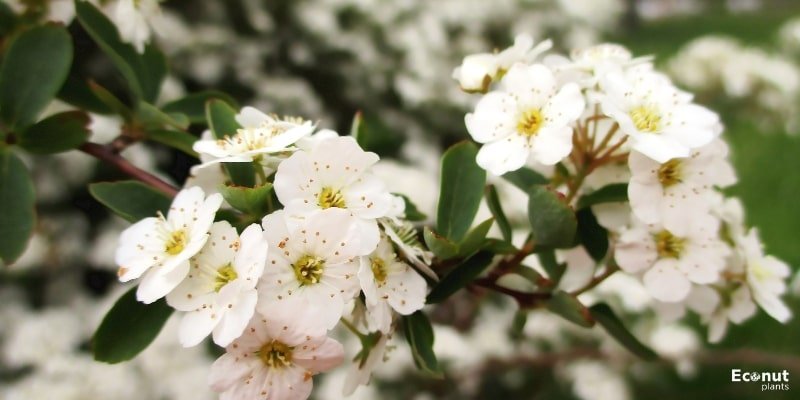
Botanical Name: Spirea prunifolia
Plant Type: Deciduous
Sun Exposure: Full sun
Water Needs: Moderate
Spireas are medium-sized shrubs that grow quickly, have eye-catching blossoms, and require very little maintenance from gardeners. They are ideal for a space you need to fill quickly because they can grow to their full height in just one year. They can tolerate many types of soil as long as it stays moist, but they thrive in full sun.
The spirea cultivar, known as Bridalwreath, is an exquisite plant. Its trailing branches are long and curved in the direction of the ground. These branches are almost entirely covered with tiny, fragile blooms in the spring before the leaves grow. Small, oblong leaves appear later in the foliage and typically turn golden-orange and purple in the autumn.
2. Green Velvet Boxwood

Botanical Name: Buxus x ‘Green Velvet’
Plant Type: Evergreen
Sun Exposure: Full sun to partial shade
Water Needs: Moderate
Evergreen shrubs, known as boxwoods or box shrubs, are frequently used as topiaries and hedges; however, they can also be left alone and tolerate neglect. These plants are well-liked because of their compact, dense foliage, which maintains a tidy, well-groomed look even when left to grow untended.
If left untrimmed, green velvet is medium-sized boxwood that can reach a height of 4 feet. It grows organically into a low, rounded shape and has lovely, dense, bright green foliage.
This shrub may grow in full sun or moderate shade and is particularly resilient to cold weather. This is the shrub to choose if you want it to appear as though you’ve given it much more care than you have!
3. Moonglow Juniper
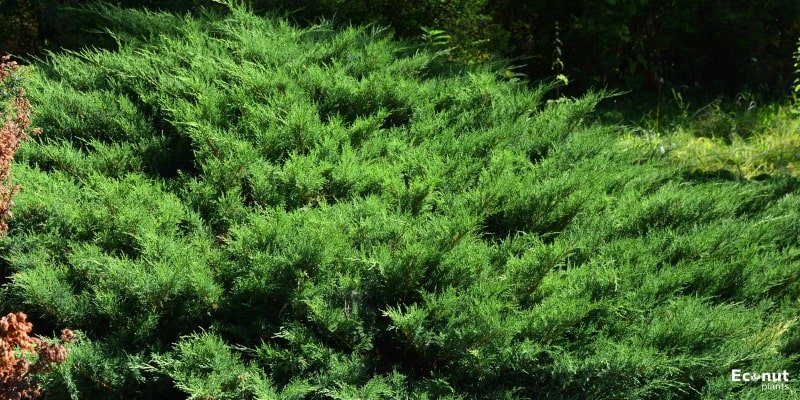
Botanical Name: Juniperus scopulorum ‘Moonglow’
Plant Type: Evergreen
Sun Exposure: Full sun
Water Needs: Moderate
Junipers are little conifers that are helpful for distilling gin and have beautiful evergreen foliage and berries. With their tall stature and upright growing habit, they create extremely attractive, tall hedges. They need full light and well-drained soil, but they are simple to maintain. Not all junipers can withstand extreme heat, although they do tolerate drought extremely well.
Moonglow juniper is a lovely cultivar. When fully grown, it can reach a height of 20 feet and have a narrow growth habit. It’s a great privacy hedge or windscreen.
It is believed that this cultivar is dwarf. The most distinctive features of Moonglow are its vivid blueberries and lovely grayish-green leaves. It can withstand both damp and dry soil, although it isn’t sensitive to the pH of the soil. It will not, however, tolerate wet soil.
4. Possumhaw
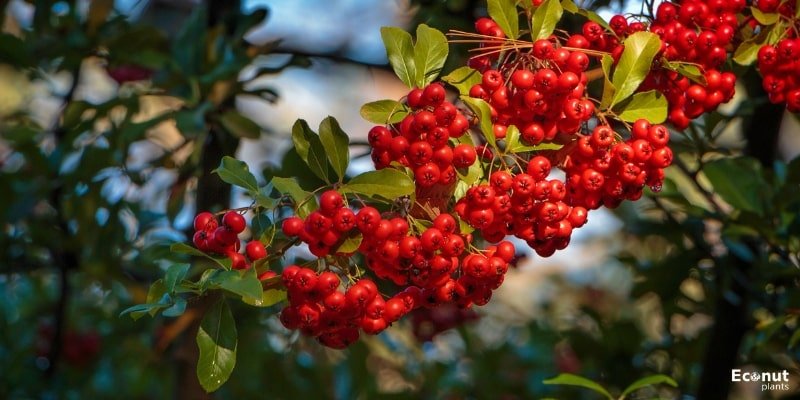
Botanical Name: Ilex decidua
Plant Type: Perennial
Sun Exposure: Full sun to partial shade
Water Needs: Moderate
The possumhaw belongs to the holly family and is a deciduous tree. It does not keep its green, toothy leaves throughout the year; instead, in the autumn, it turns purple and then yellow, leaving only the bare branches covered with rich red berries for the winter birds to eat. Given that both male and female plants are required for berry production; this is a shrub that grows well in clusters.
Possumhaw, commonly referred to as winterberry or prairie holly, grows in a spherical manner up to 15 feet tall, sometimes much higher. It just requires pruning for shaping and can withstand clay and less fertile soil types. It is not very drought-tolerant and does require moist soil.
5. Royal Princess Nandina
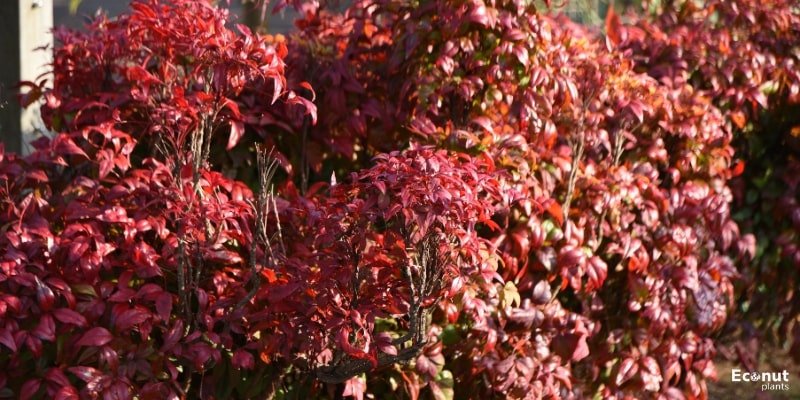
Botanical Name: Nandina domesticaa
Plant Type: Evergreen or Deciduous
Sun Exposure: Full sun to partial shade
Water Needs: Moderate
Heavenly bamboo, or nandina, is a distinctive and beautiful plant that is typically evergreen but may lose its leaves during prolonged cold spells. This is a terrific addition to the landscape if you’re searching for a low-maintenance shrub with personality. The leaves change colour in the fall and give the garden a burst of crimson, even though they don’t always fall in the winter.
The height of the Royal Princess is a medium shrub, reaching a maximum of 6 to 8 feet. It features tall branches that have a little space at the bottom before branching out and producing gorgeous, delicate foliage.
Little white flowers that bloom all summer long cover, Royal Princess. The blossoms turn into beautiful red berries in the late autumn and winter months. This plant provides interest in the garden for four seasons, as the leaves revert to their original hue in the spring.
6. Virginia Sweetspire

Botanical Name: Itea virginica
Plant Type: Semi-Evergreen
Sun Exposure: Full sun to partial shade
Water Needs: Moderate
The Virginia sweetspire may be the ideal decorative shrub. Even though it is only 5 feet tall, it is not difficult to maintain or become unruly. The entire shrub is nearly covered in fragrant, 5-inch-long spires of white blooms in the spring. These blooms are very appealing, but they also attract a lot of pollinators.
It is an excellent foundation plant for annual blooming plants since its leaves intensify to dark green in the summer. The foliage puts on quite a display in the autumn as it transforms from green to hues of crimson, purple, yellow, and orange before losing its leaves for the summer. Virginia Sweetspire prefers low-maintenance, wet, somewhat acidic soil.
7. Winecraft Black Smokebush
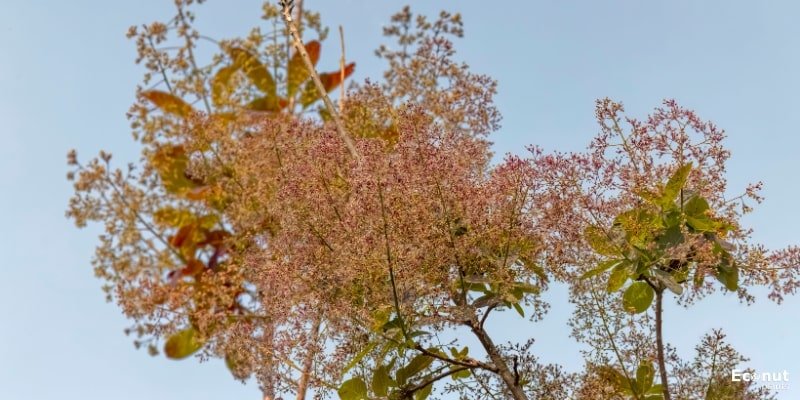
Botanical Name: Cotinus coggygria ‘Minecraft Black’
Plant Type: Deciduous
Sun Exposure: Full sun
Water Needs: Moderate
A group of deciduous, tiny trees or shrubs known as “smokebush” have long, hair-like features that resemble puffs of smoke and fluffy, smoke-like flower plumes. They can grow up to 15 feet tall at a medium pace, and if desired, they can be clipped to resemble miniature trees. Except damp soils, they can grow in most types of soil and prefer full sun.
Winemaking The black smokebush is breathtaking. The flower clusters and the foliage are almost the same shade of deep merlot red, with rounded leaves. When planted in a group, this cultivar creates an impressive hedge in addition to being a lovely specimen when grown alone.
8. Yuletide Camellia

Botanical Name: Camelia sasanqua ‘Yuletide’
Plant Type: Evergreen
Sun Exposure: Full sun to Partial shade
Water Needs: Low
Only occasional branch pruning and yearly fertilization are needed for these lovely, evergreen camellias. Even in a protracted drought, the sasanqua species tolerates extreme temperatures well and needs little watering. Throughout the year, they display gorgeous, glossy, dark leaves, and in the winter, they bear stunning blooms.
As the winter holidays approach, Yuletide blossoms. Lovely little red blooms with brilliant yellow stamen clusters in the center are produced by this medium- to large-sized camellia. The blooms attract pollinators and provide an important source of food during the winter months.
9. Autumn Moonlight Azalea
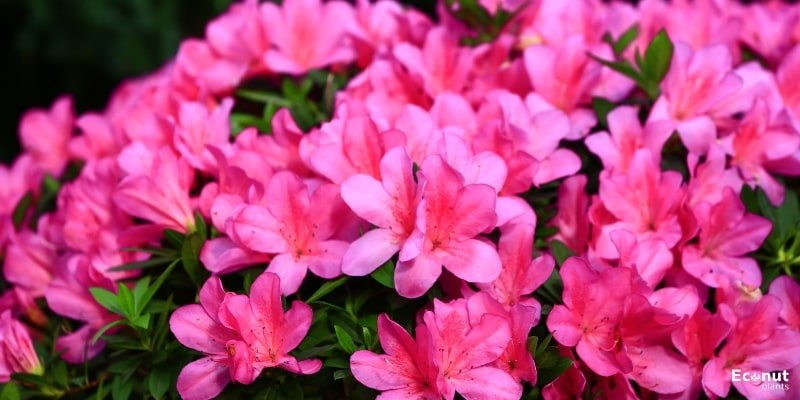
Botanical Name: Rhododendron ‘Mootum’ PP18416
Plant Type: Evergreen
Sun Exposure: Full sun to Partial shade
Water Needs: Low
Autumn Moonlight azalea, a part of the Encore line, is special because it blooms in spring, reblooms in summer, and occasionally falls.
Although this kind of azalea can withstand full sun, it will blossom best if it receives six or more hours of sunlight every day. Most azaleas prefer partial sun. Once established, which happens fast, azalea plants require very little care and thrive on neglect.
Mid-sized Autumn Moonlight azaleas have tiny, attractively formed leaves. It produces an abundance of pure white, double-form flowers in bloom. Like all azaleas, it is evergreen; thus, its leaves are retained throughout the year, making it a lovely shrub and component of landscape design. In large enough growing spaces, it can also thrive in containers.
10. Blue Bird Hibiscus

Botanical Name: Hibiscus syriacus ‘Blue Bird’
Plant Type: Deciduous
Sun Exposure: Full sun to Partial shade
Water Needs: Moderate
Many tropical and deciduous flowering shrubs belong to the genus Hibiscus. While they can withstand a variety of lighting situations, deciduous plants prefer full sun for optimal flowering.
They require rich, moist soil for optimal growth. In autumn, they shed their leaves and often display bronze and gold hues in their foliage, which creates an interesting third season.
An authentic blue strain of H. syriacus is called “Blue Bird.” With breathtaking blue-violet blooms that have a deep crimson eye that bleeds into the petals, this fast-growing plant can grow up to 8 feet tall. A lovely blooming hedge or focal point for a summer garden, the medium green foliage is quite appealing.
11. Cinnamon Viburnum
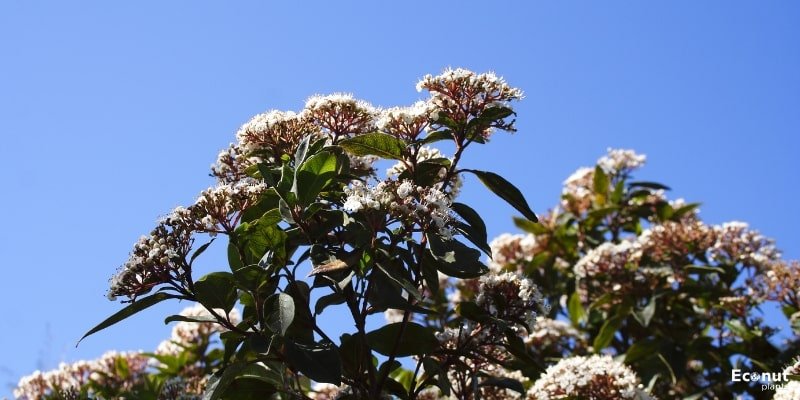
Botanical Name: Viburnum cinnamomifolium
Plant Type: Evergreen
Sun Exposure: Full sun to Partial shade
Water Needs: Moderate
Shrubs with beautiful blossoms and viburnums are widely used in landscaping and are much sought after. The most striking feature of cinnamon viburnum, nevertheless, is its lovely leaves.
Though they are small and unimpressive, the flowers do bloom on them. The mature height of cinnamon, which can reach up to 20 feet in height but is usually only reached after 10 or more, years of cultivation, is a slow-growing cultivar.
Vast, elliptic, and heavily veined leaves characterize this evergreen plant. Spring brings light green young leaves, which in summer turn a considerably deeper shade of the same colour. Despite preferring somewhat acidic soil, cinnamon viburnum is not fussy about soil or sunlight.
12. Crimson Fire Loropetalum

Botanical Name: Loropetalum chinense var. Rubrum
Plant Type: Evergreen
Sun Exposure: Full sun to Partial shade
Water Needs: Average
The wonderful Loropetalum cultivar, Crimson Fire, is ideal for cramped places. It grows quickly; by the second year, it is only 3 to 4 feet tall at maturity. Evergreen shrubs with flowers (loropetalum) thrive in warm regions but may withstand very cold temperatures. They tolerate drought well once established and grow well in both full sun and moderate shade.
The vivid, burgundy leaves of this dwarf cultivar make it stand out. The leaves have a ruby-red appearance at first, which gradually deepens and stays red all year.
Spidery clusters of neon pink blooms bloom at the tips of the branches in the spring, attracting butterflies and hummingbirds with their copious amounts of sweet nectar. This small plant thrives in a transportable container so that the fragrant blossoms can be enjoyed by moving it closer to living areas.
13. Frostproof Gardenia
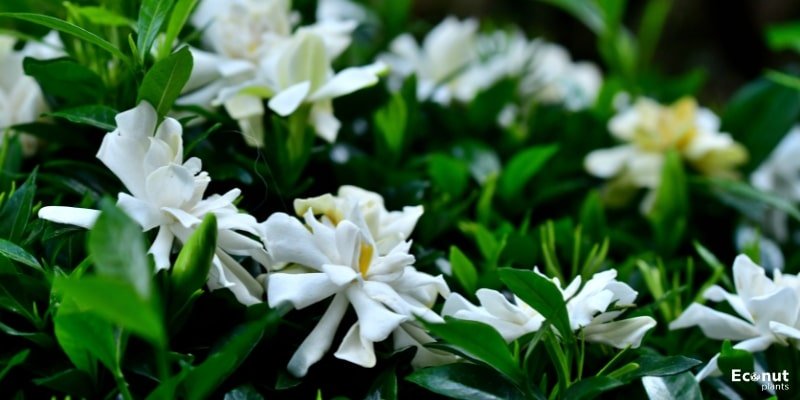
Botanical Name: Gardenia jasm inodes ‘Frostproof’
Plant Type: Evergreen
Sun Exposure: Full sun to Partial shade
Water Needs: Moderate
In my yard, this is one of the simplest and hardest plants. Gorgeous evergreen plants called gardenias yield the most deliciously smelling blossoms. Although they require some work at first, if you plant when the conditions are appropriate, you can skip the initial months of watering while the plant develops itself. These plants may withstand a little neglect after that.
The Frostproof variety is a great little cultivar that grows slowly, taking several years to achieve maturity and reaching a height of around 5 feet. Though somewhat smaller than other types, the blossoms are nonetheless very fragrant.
Surprisingly, for such a cold-tolerant plant, the foliage is delicate. This past winter, after five days with 20-degree temperatures, both of my Frostproof Gardenias looked as perky and green as ever.
14. Fragrant Tea Olive

Botanical Name: Osmanthus fragrans
Plant Type: Evergreen
Sun Exposure: Full sun to Partial shade
Water Needs: Low
If you live in the American South, your garden must include this big plant. The aromatic tea olive is as timeless as camellia and represents coziness and welcome.
This evergreen shrub will welcome guests with its wonderfully scented flowers if you plant it near your front door. Tiny, barely noticeable blossoms emerge in the spring and fall on tea olives. Because they may be used to make perfume and other cosmetic smells, these blossoms are very sought-after.
Fragrant Tea Olive belongs to the Oleacae family of olives. When planted in a group, it grows taller than it is wide and creates a lovely privacy hedge or screen. Once planted, the glossy, deep green foliage of this shrub will grow with little to no attention.
15. Hinoki Cypress
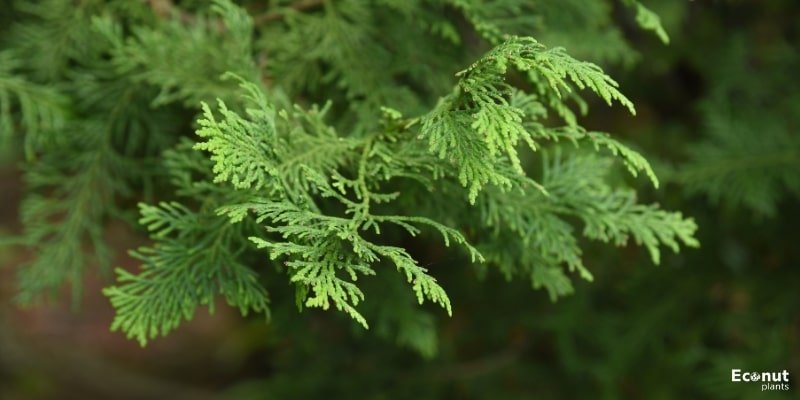
Botanical Name: Chamaecyparis obtuse
Plant Type: Evergreen
Sun Exposure: Full sun
Water Needs: Low
Technically speaking, this and all cypresses are trees. Nonetheless, this tree is frequently pruned shorter and cultivated as a shrub. The genus Cypress contains slow-growing, extremely long-lived trees that can withstand poor soil types as long as they receive moderate precipitation during the establishment phase. They can thrive in some shade, but they also like full sun.
The Japanese type of cypress known as hinoki has long, drooping branches that give it a weeping appearance. Its full-sized form is frequently employed as a privacy screen, while its dwarf form is suitable for bonsai. Once established, it has very attractive foliage and a high tolerance to drought.
16. Meadowlark Forsythia
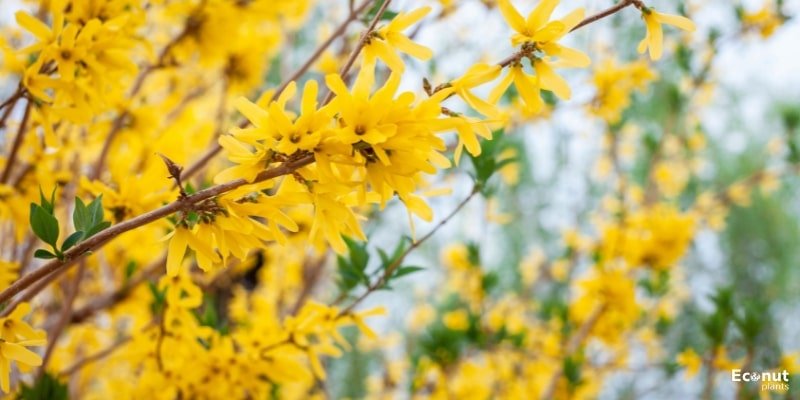
Botanical Name: Forsythia x intermediaa ‘Meadowlark’’
Plant Type: Deciduous
Sun Exposure: Full sun to partial shade
Water Needs: Moderate
I was enthralled by the beauty of the Forsythia bush in bloom when I was a child, and it was located at the end of our driveway. Since our neighbour’s name is Cynthia, I assumed for years that the name must be her shrub, even though, at the age of three, I was unable to pronounce it correctly and instead believed that my mother had called it “For Cynthia.”
The meadowlark is a deciduous shrub with flowers that grows quickly. When grown properly, it can grow up to 2 feet a year and reach a maximum height of 10 feet.
The vivid yellow blossoms of the bushes bloom on bare wood in the spring, unhindered by vegetation. These plants are low-maintenance once established and create a lovely focal point in the spring. Their foliage is lovely through the summer and fall as well.
17. Oakleaf Hydrangea

Botanical Name: Hydrangea quercifolia
Plant Type: Deciduous
Sun Exposure: Full sun to partial shade
Water Needs: Moderate to High
The appeal of hydrangeas is undeniable. For those looking to add colour to their summer garden, their gorgeous, long-lasting blossoms are quite attractive and make excellent-cut flowers. The appearance of oakleaf hydrangea is a little odd. Oakleaf hydrangeas have lobed leaves that resemble oak leaves, as opposed to the typical elliptic, plain leaves of normal hydrangeas.
The oakleaf hydrangea is a wonderful foundation plant or focal point because it grows to a height of around 8 feet at maturity. As they mature, the blossoms progressively change from white to pink or purple.
With its lovely, rounded growth habit, the plant will require little upkeep or pruning. Oakleaf foliage changes to bronze, orange, and purple hues in the autumn. As their name suggests, hydrangeas do require a substantial quantity of water. A moisture sensor makes it easy and reasonably priced to check the moisture content of your soil.
18. Rain of Gold

Botanical Name: Galphimia glauca
Plant Type: Evergreen or Deciduous
Sun Exposure: Full sun
Water Needs: Low
One of my favourites is Rain of Gold, or Thryallis. It thrives in Zone 8, even though it is primarily found in tropical and subtropical regions, provided that it is protected from freezing winter winds.
The leaves on the brilliant green, rather delicate foliage are paired and placed along branches that are capped with flowers.
Cheerful spikes of bright yellow blooms that are highly enticing to pollinators are the flowers that bloom throughout most of the summer. This plant produces a magnificent specimen, especially in the summer, but it is not the ideal choice for a privacy hedge because of its very thin leaf.
19. Tuscan Blue Rosemary

Botanical Name: Rosmarinus officinalis ‘Tuscan Blue’
Plant Type: Evergreen
Sun Exposure: Full sun
Water Needs: Low
Rosemary is a great choice if you’re searching for a shrub that can be used in both the kitchen and the garden. These Mediterranean bushes are practically better off left alone. Evergreen and having needle-like foliage, rosemary has a lovely scent and can be used as an herb to quickly transform potatoes from plain to perfectly cooked sourdough bread.
“Tuscan Blue” is a big cultivar that can reach a height of six feet. Once established, it only requires watering during extended droughts, as it has very little requirement for water.
Masses of light blue blooms bloom at the tips of branches from winter to spring, giving this already amazing garden accent even more visual intrigue.
20. Wax-leaf Privet
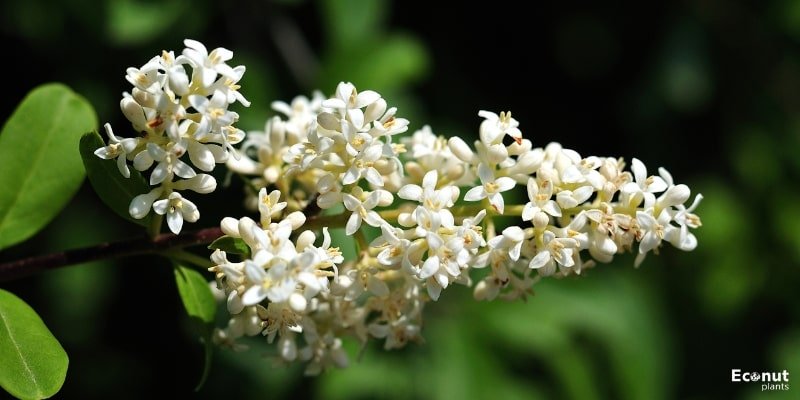
Botanical Name: Ligustrum japonicum ‘Texanum’
Plant Type: Evergreen
Sun Exposure: Full sun to partial shade
Water Needs: Low to Moderate
Ligustrums require extremely little care; in fact, you may essentially plant them and forget about them. On the far side of my property, I have four of them that receive very little attention from anyone other than the bees.
Growing in most types of soil, wax-leaf privet is easy. When originally planted, it needs considerable watering, but once established, it resists drought amazingly well.
The wax-leaf privet bears copious amounts of fragrant white blooms in the early summer. These blooms provide a light, sweet, floral-tasting honey and are an important source of food for pollinators. They thrive in full sun or partial shade and are fairly resistant to pests and illnesses. They look good in containers as well.
21. American Beautyberry
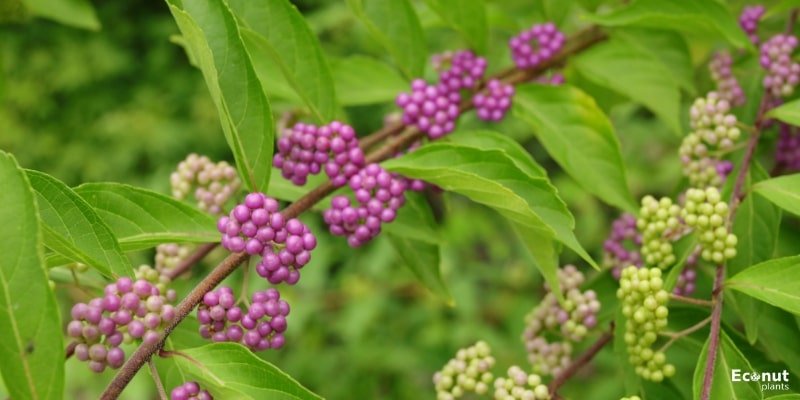
Botanical Name: Callicarpa Americana
Plant Type: Deciduous
Sun Exposure: Full sun to partial shade
Water Needs: Low
American Beautyberry is my favourite low-maintenance shrub; therefore, let’s start the list with it. It’s the easiest plant I’ve ever encountered in terms of maintenance, and it looks great too. According to most publications, this shrub can only reach a height of 9 feet in ideal circumstances, yet I have a shrub in my backyard that is closer to 12 feet tall.
Large, light green leaves on long, graceful branches adorn the beautyberry. Pollinators love the delicate pink flowers that the bush produces in bunches during the spring and early summer. The little blossoms give way to the most gorgeous, vivid purple berries towards the end of summer. Autumn brings a golden hue to the foliage, giving the plant a third season of interest.
22. Bird’s Nest Spruce

Botanical Name: Pisces abies ‘Nidformis’
Plant Type: Evergreen
Sun Exposure: Full sun to partial shade
Water Needs: Moderate
Bird’s Nest spruce is a charming little evergreen shrub that can be neglected and needs very little care. It grows well in both spring and autumn and is tolerant of a variety of soil types and lighting conditions.
It has few to no problems with illnesses or pests because deer and other wildlife don’t care for it and usually leave it alone, features long, dense branches with classic spruce foliage—light green at first, but maturing to a deeper grayish-green.
The term “bird’s nest” refers to the slow-growing plant that tends to dip slightly at the top of its leaf, creating a structure resembling a nest. After it’s established, it just needs fertilizer and water during dry spells once a year and little to no pruning.
23. Bottlebrush Buckeye

Botanical Name: Aesculus parviflora
Plant Type: Deciduous
Sun Exposure: Full sun to partial shade
Water Needs: Moderate
The bottlebrush buckeye is a somewhat large shrub, growing to a height of 8 to 12 feet with a frequently larger spread, despite its diminutive size for a buckeye. Buckeyes usually finish flowering by summer, but bottlebrush buckeye continues to bloom well into that season.
In comparison, it is also very resistant to illnesses and pests. Give this plant some protection from the sun, as it is prone to sunburn in direct sunlight.
The leaves are beautiful, thick, and sizable. They have a deep green colour in the spring and summer, which changes to a gorgeous golden hue in the autumn.
It bears tall spires of tiny white blooms in the summer that resemble the bottlebrush that gives it its popular name. Although it can tolerate most soil types, it occasionally needs a little more water. Drought, but aside from that, it’s a hardy shrub that looks great when placed beneath bigger trees.
24. Common Winterberry
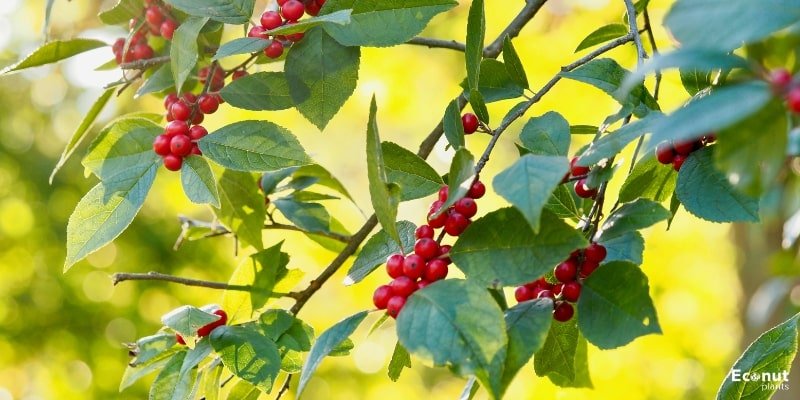
Botanical Name: Ilex verticillata
Plant Type: Deciduous
Sun Exposure: Full sun to partial shade
Water Needs: High
The common winterberry is a fascinating plant that belongs to the holly family and is a deciduous member. This shrub is excellent for low-lying garden places where it will receive plenty of water or for areas with poor drainage. It can also survive in alkaline, salted, and moist soil.
Neglect doesn’t bother these bushes as long as there’s moisture. This slow-to-moderate grower matures into a lovely, huge shrub that is about 10 feet tall.
The leaves of common winterberries are lustrous and green in the spring and summer and turn golden in the autumn. It bears tiny, barely noticeable white flowers. Fertilized blossoms bear vivid red berries that withstand the winter and provide food for birds that migrate south for the winter. Plants with male and female parts are both required for the production of fruit.
25. Indian Hawthorn

Botanical Name: Rhapiolepis India
Plant Type: Evergreen
Sun Exposure: Full sun
Water Needs: Moderate
The hawthorn family comprises well-liked small to medium-sized flowering shrubs that can withstand a lot of neglect and have nice-looking foliage. Given the proper growing conditions, the Indian hawthorn, a native of Asia, requires very little upkeep.
They like plenty of sunlight, appropriate airflow, and drainage. After they are established, plants can withstand protracted droughts with only minimal watering.
With a gradual growth rate, Indian hawthorn can grow up to 6 feet tall. As the leaves age, they turn a beautiful dark green from their youthful bronze colour.
Oblong in shape, the leaves have sharp edges and a glossy, leathery feel. Little, fragrant blossoms that are pink or white clusters appear in the spring. In bunches at the ends, the star-shaped blooms of branches.
26. Red Prince Weigela
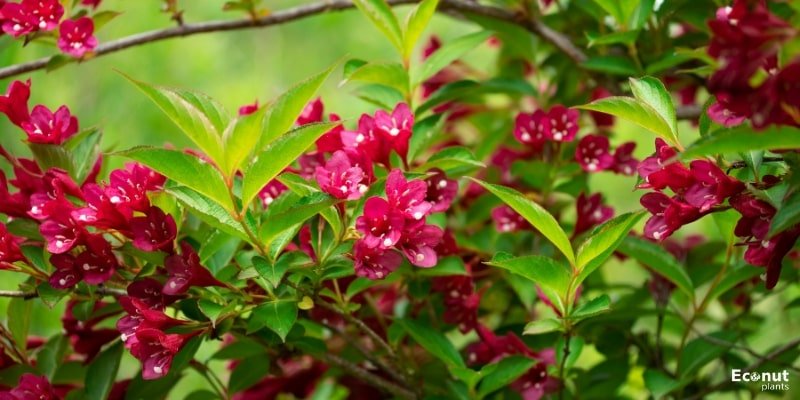
Botanical Name: Weigela Florida
Plant Type: Deciduous
Sun Exposure: Full sun
Water Needs: Moderate
A genus of bushes with flowers called Weigela is connected to the honeysuckle family. They originated in Asia and were brought to Europe in the 1800s before being brought to North America, where they are frequently planted as ornamentals. Sun-loving Weigela grows quickly. They require little upkeep and exhibit excellent resilience to illnesses and pests.
Weigela Florida, often known as Red Prince, is a common name for this erect shrub with an oval to rounded growth habit. This 6’–9′ shrub’s dense foliage makes it an excellent choice for a privacy hedge or focal point in the garden.
Red Prince produces a profusion of small, beautiful red funnel-shaped flowers in the spring that hummingbirds find particularly appealing.
27. Emerald Gaiety Euonymus
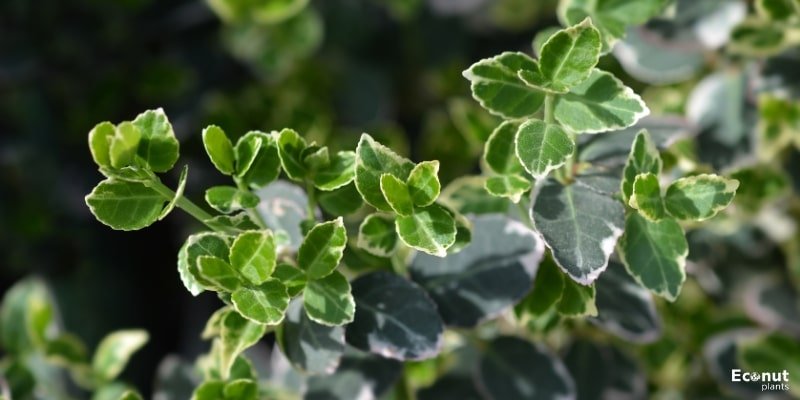
Botanical Name: Euonymus fortunei
Plant Type: Evergreen
Sun Exposure: Full sun to partial shade
Water Needs: Moderate
A group of evergreen or deciduous shrubs known as Euonymus may display brilliantly coloured foliage in the autumn in addition to blooming and producing little fruits. That being said, “Emerald Gaiety” is evergreen, meaning that its leaves stay colourful throughout the year.
Generally speaking, the genus is not fussy about sun exposure and is highly tolerant of many soil kinds. If there’s enough bright light available, even indirect light will suffice.
A shrub of medium size with gorgeous foliage is called “Emerald Gaiety.” Winter turns the creamy white borders of the emerald green leaves to a pink hue. You may choose to let this shrub grow naturally in a mound or prune it into a lovely, well-groomed form.
When Euonymus is well-established, it can withstand periods of severe drought without much need for watering.
Conclusion
Any of these shrubs that require little upkeep can be added to your garden to reduce the amount of work involved in maintaining your landscaping or to free up time for other, higher-maintenance plants.
These shrubs provide great foundations or focal pieces for your landscaping and require very little maintenance.

